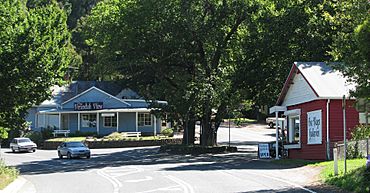Kalorama, Victoria facts for kids
Quick facts for kids KaloramaMelbourne, Victoria |
|||||||||||||||
|---|---|---|---|---|---|---|---|---|---|---|---|---|---|---|---|

"Five Ways", Kalorama
|
|||||||||||||||
| Population | 1,277 (2021 census) | ||||||||||||||
| • Density | 399/km2 (1,030/sq mi) | ||||||||||||||
| Postcode(s) | 3766 | ||||||||||||||
| Area | 3.2 km2 (1.2 sq mi) | ||||||||||||||
| Location | |||||||||||||||
| LGA(s) | Shire of Yarra Ranges | ||||||||||||||
| State electorate(s) | Monbulk | ||||||||||||||
| Federal Division(s) | Casey | ||||||||||||||
|
|||||||||||||||
Kalorama is a lovely suburb located in Melbourne, Victoria, Australia. It is about 35 kilometers (22 miles) east of Melbourne's main city area. Kalorama is part of the Shire of Yarra Ranges, which is a local government area. In 2021, about 1,277 people lived here.
Contents
Welcome to Kalorama!
Kalorama is known for its beautiful scenery and peaceful atmosphere. It is a great place to explore nature and enjoy the outdoors. The area is part of the stunning Dandenong Ranges.
A Look Back in Time
European settlers first came to Kalorama around 1855. Some of the first people to settle here were Isaac Jeeves, Mathew Child, and Jabez Richardson. Before them, the land belonged to the Wurundjeri people. They are the traditional owners of this area and part of the Kulin nation.
The local Post Office opened on October 1, 1909. It had a few different names over the years. First, it was called Hand's Corner until 1910. Then, it became Mount Dandenong North until 1926. Finally, it was named Kalorama.
Nature's Beauty
Kalorama is surrounded by amazing forests. These forests are mostly filled with different types of Eucalyptus trees. One of the most impressive is the mountain ash (Eucalyptus regnans). This tree is the tallest known flowering plant in the world!
These wet sclerophyll forests are home to many native birds. You might even hear the superb lyrebird (Menura novaehollandiae). These birds are famous for their incredible ability to mimic sounds. They can copy the calls of other birds, animals, and even human sounds! You can sometimes hear them from the deeper valleys.
Fun Things to See and Do
One of the most famous spots in Kalorama is a lookout point called "Five Ways". From here, you can see amazing views. You can look out over Kalorama Park and the Silvan Reservoir. You can also see the National Rhododendron Gardens and the R J Hamer Arboretum. An arboretum is like a botanical garden, but it focuses on trees and shrubs.
There are many other fun places to visit nearby. You can explore the William Ricketts Sanctuary. This sanctuary has unique sculptures hidden in the bush. You can also visit Olinda Falls, a beautiful waterfall. The area also has art galleries, cozy tea-rooms, cafes, and shops.
Kalorama in Art
The beautiful landscapes of Kalorama have inspired many artists. Famous Australian artists have featured the area in their work. One well-known artist who painted scenes from this region was Sir Arthur Streeton.


